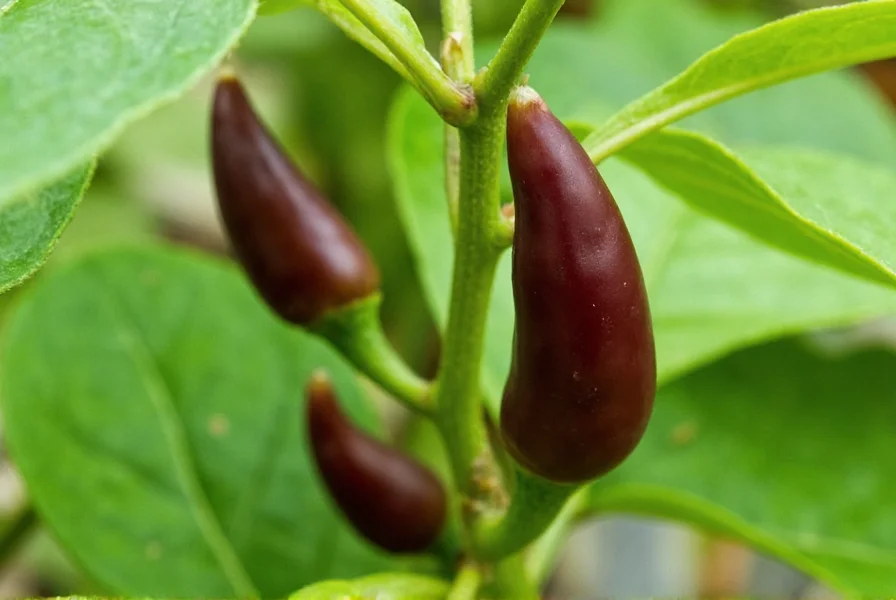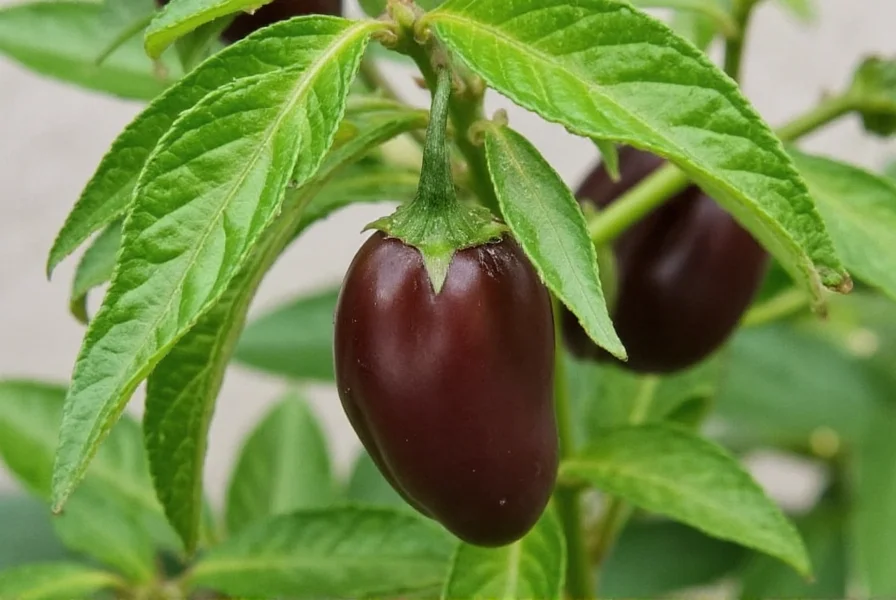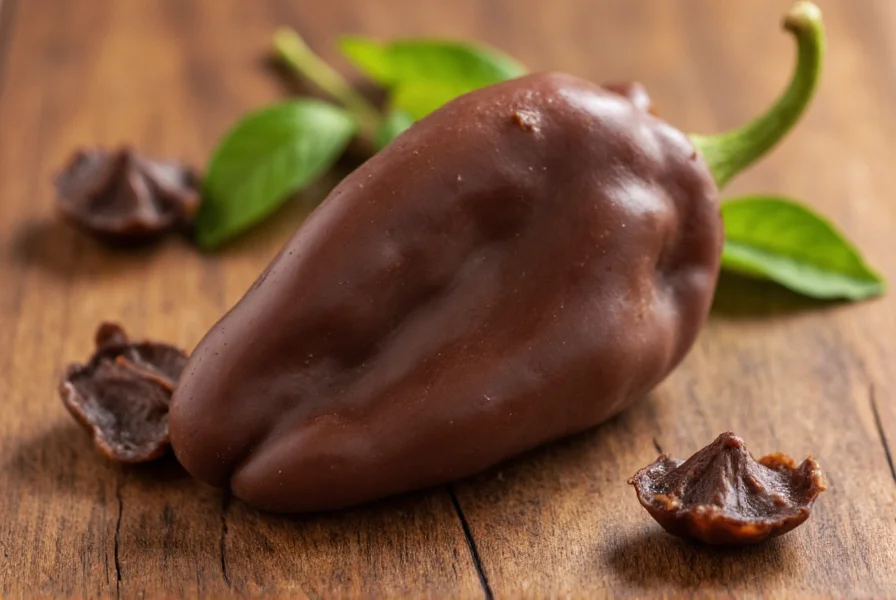Understanding the Chocolate Ghost Pepper
Among the many color variations of the infamous Bhut Jolokia, the chocolate ghost pepper stands out for its rich brown hue and nuanced flavor profile. While sharing the same genetic lineage as the original ghost pepper that once held the Guinness World Record for hottest chili, this variant offers growers and culinary enthusiasts a visually distinctive option without compromising on heat intensity.
What Makes It "Chocolate"?
The "chocolate" designation refers solely to the mature pod's coloration, not to any cocoa content or flavor. As the peppers ripen, they transition from green to a deep chocolate brown rather than the more common red, orange, or yellow variants. This color variation results from specific anthocyanin pigments expressed during the final ripening stages.
| Ghost Pepper Color Variant | Typical Color at Maturity | Heat Level (SHU) | Distinctive Flavor Notes |
|---|---|---|---|
| Chocolate Ghost | Deep brown | 855,000-1,041,427 | Earthy, smoky, tobacco |
| Red Ghost | Bright red | 855,000-1,041,427 | Fruity, slightly sweet |
| Yellow Ghost | Bright yellow | 800,000-1,000,000 | Citrusy, tropical |
| Purple Ghost | Purple | 800,000-950,000 | Floral, berry notes |
Heat Level Analysis
Despite its different appearance, the chocolate ghost pepper maintains the same formidable heat as its red counterpart. Measuring between 855,000 and 1,041,427 Scoville Heat Units, it's approximately 200-400 times hotter than a jalapeño. The heat builds gradually, starting with a fruity sweetness before delivering its signature intense burn that can last up to 45 minutes. Those interested in chocolate ghost pepper Scoville rating comparisons should note that color variants don't significantly alter heat potential—the growing conditions and plant stress factors play larger roles in final heat intensity.

Flavor Profile Beyond the Burn
Before the heat overwhelms your senses, chocolate ghost peppers offer a complex flavor experience. They begin with a subtle fruitiness, quickly developing earthy, smoky notes reminiscent of dark chocolate or tobacco—hence the name. This distinctive chocolate ghost pepper flavor profile makes it particularly valuable for craft hot sauces and specialty dishes where depth of flavor matters as much as heat. Unlike some other super-hots that offer little beyond capsaicin burn, experienced chili enthusiasts appreciate the chocolate variant's more nuanced taste.
Growing Chocolate Ghost Peppers
Cultivating chocolate ghost peppers requires the same conditions as other Bhut Jolokia variants. These plants need:
- 100-120 days to reach maturity from seed
- Consistent temperatures between 75-90°F (24-32°C)
- Well-draining soil with pH 6.0-7.0
- Regular watering without waterlogging
- Full sun exposure for at least 6-8 hours daily
For those seeking chocolate ghost pepper growing tips, note that the distinctive brown color develops during the final ripening phase. Harvesting too early yields green peppers that will eventually turn brown off the plant, but allowing them to mature fully on the vine produces the deepest color and most developed flavor. Gardeners researching chocolate ghost pepper seeds should verify they're purchasing from reputable sources, as mislabeled seeds are common in the super-hot pepper market.
Culinary Applications
The chocolate ghost pepper's unique flavor profile makes it particularly valuable in specific culinary applications. Chefs working with this ingredient often use it in:
- Dark chocolate chili rubs for meats
- Smoky hot sauces with coffee or cocoa notes
- Specialty Bloody Mary mixes
- Complex mole sauces
- Infused oils for finishing dishes
When cooking with chocolate ghost pepper, remember that a little goes an extremely long way. Most recipes require only 1/4 to 1/2 of a pepper for an entire batch of sauce serving 6-8 people. Those exploring chocolate ghost pepper uses should always wear gloves when handling and avoid touching their face. The capsaicin oils can cause severe irritation to sensitive areas.
Safety Considerations
Working with any ghost pepper variant requires serious precautions. The chocolate ghost pepper's heat can cause:
- Skin irritation and chemical burns
- Respiratory distress when cutting or processing
- Severe gastrointestinal distress if consumed in excess
- Eye damage if oils transfer from hands
Always use nitrile gloves (latex won't protect against capsaicin), work in well-ventilated areas, and have dairy products like milk or yogurt nearby to counteract the burn if accidentally consumed. Never use blenders or food processors without proper ventilation, as they aerosolize the capsaicin oils.
Chocolate vs. Red Ghost Peppers
Many enthusiasts wonder about chocolate ghost pepper vs regular ghost pepper differences. While their heat levels are virtually identical, the chocolate variant offers:
- More complex flavor profile with earthy notes
- Darker color that works well in specific sauces
- Slightly thicker walls that may affect drying characteristics
- Same cultivation requirements and maturation timeline
The choice between variants ultimately comes down to personal preference and intended culinary application. Those seeking pure heat won't notice a difference, but chefs valuing flavor complexity often prefer the chocolate variant for specific recipes.

Conclusion
The chocolate ghost pepper represents one of the most intriguing color variants within the Bhut Jolokia family. While maintaining the extreme heat that made ghost peppers famous, it offers a distinctive flavor profile and visual appeal that has earned it a dedicated following among chili enthusiasts. Whether you're a home gardener looking to expand your pepper collection or a chef seeking complex heat for specialty dishes, understanding the unique characteristics of this chocolate-colored super-hot can help you work with it safely and effectively. Remember that proper handling techniques are essential when working with any pepper at this heat level, but the rewards in flavor complexity make the chocolate ghost pepper worth the effort for experienced chili aficionados.
Frequently Asked Questions
How hot is a chocolate ghost pepper compared to other super-hots?
Chocolate ghost peppers measure between 855,000 and 1,041,427 Scoville Heat Units, placing them on par with regular ghost peppers and significantly hotter than habaneros (100,000-350,000 SHU). They're slightly less hot than Carolina Reapers (1,400,000-2,200,000 SHU) but considerably hotter than most commercially available peppers. The heat builds gradually but can last up to 45 minutes, with the chocolate variant offering more earthy flavor notes before the intense burn sets in.
Can you eat chocolate ghost peppers raw?
While technically possible to eat chocolate ghost peppers raw, it's strongly discouraged for all but the most experienced chili eaters. The extreme heat can cause severe mouth and stomach irritation, nausea, and even temporary breathing difficulties. Most culinary applications use these peppers in minute quantities, often dried and powdered, to distribute the heat evenly. If attempting to eat one raw, start with just a tiny piece (1/8 of a pepper or less) and have dairy products like milk or yogurt immediately available to counteract the burn.
How do you grow chocolate ghost peppers successfully?
Chocolate ghost peppers require 100-120 days to mature from seed under optimal conditions: consistent temperatures between 75-90°F (24-32°C), well-draining soil with pH 6.0-7.0, regular watering without waterlogging, and full sun exposure for 6-8 hours daily. Start seeds indoors 8-10 weeks before last frost, using a heat mat to maintain soil temperature around 80-85°F. The distinctive chocolate color develops during final ripening, so allow peppers to mature fully on the vine for deepest color and best flavor. Use gloves when handling plants as capsaicin can transfer to skin.
What makes chocolate ghost peppers different from regular ghost peppers?
The primary difference is color and subtle flavor variations. Chocolate ghost peppers develop a deep brown to chocolate-colored pod when mature, while regular ghost peppers turn bright red. Flavor-wise, chocolate variants offer more earthy, smoky notes with hints of tobacco, whereas red ghost peppers have slightly fruitier characteristics. Heat levels remain virtually identical (855,000-1,041,427 SHU), and both require the same growing conditions. The chocolate color comes from specific anthocyanin pigments expressed during ripening, not from any genetic modification.
How should you handle chocolate ghost peppers safely?
Always wear nitrile gloves (not latex) when handling chocolate ghost peppers, as capsaicin can cause severe skin irritation. Work in a well-ventilated area or use a fan to prevent inhaling capsaicin particles, which can cause respiratory distress. Never touch your face, especially eyes, while handling. Use separate cutting boards and utensils that won't be used for other foods immediately after. After handling, wash all surfaces with soapy water and dispose of gloves properly. Have dairy products like milk or yogurt nearby in case of accidental ingestion, as water won't alleviate the burn.











 浙公网安备
33010002000092号
浙公网安备
33010002000092号 浙B2-20120091-4
浙B2-20120091-4